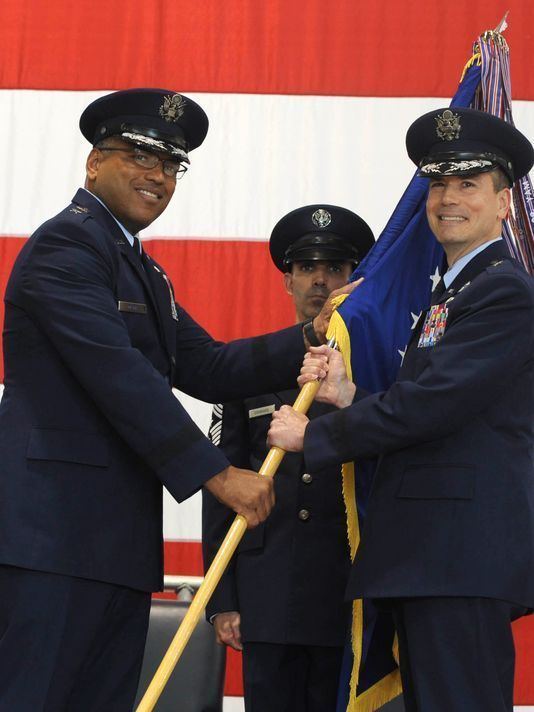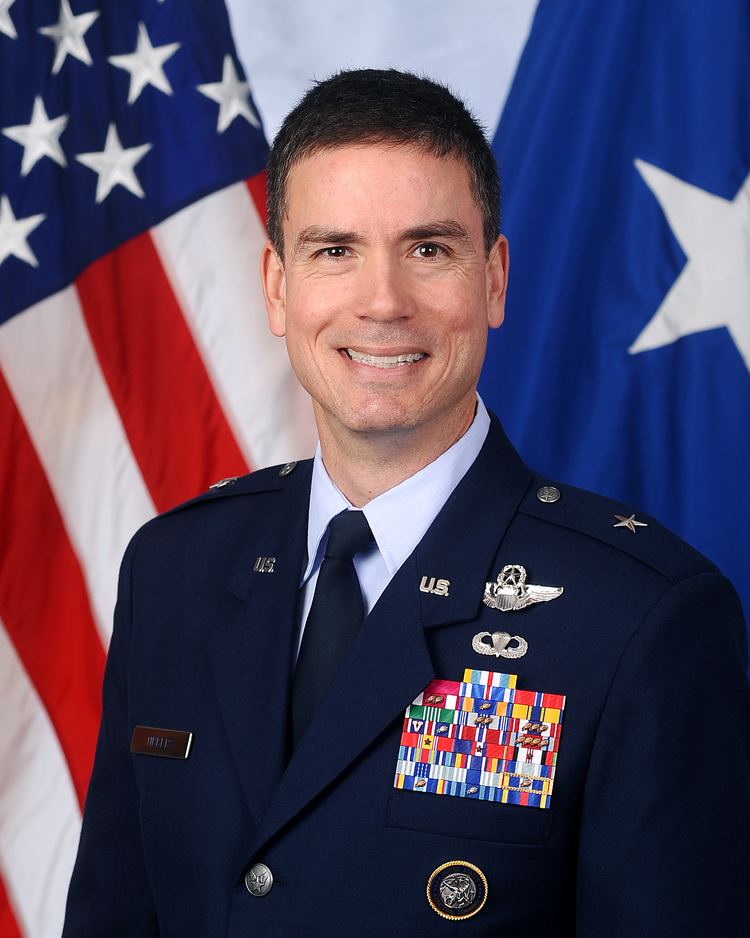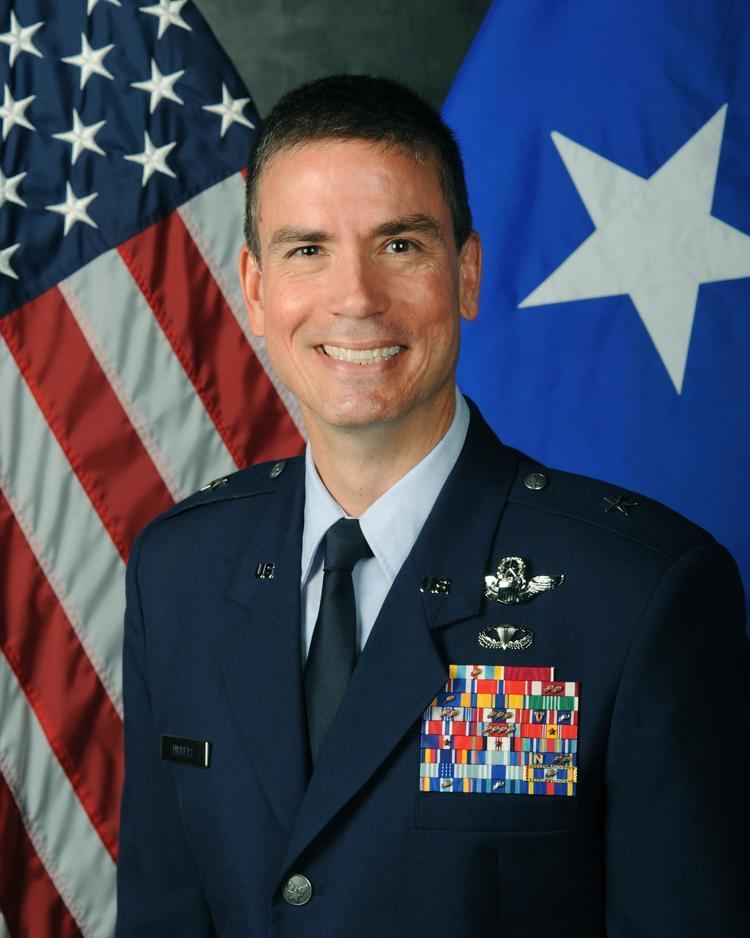Years of service 1989– Name Paul Tibbets | Rank Brigadier general | |
 | ||
Allegiance United States of America Commands held 393d Bomb Squadron509th Bomb Wing Battles/wars Operation Allied ForceOperation Iraqi FreedomOperation Enduring Freedom Awards Defense Superior Service MedalLegion of MeritDistinguished Flying CrossBronze StarAir Force Meritorious Service Medal (3)Air Medal (2)Air Force Commendation MedalArmy Commendation MedalAir Force Achievement Medal (3)Combat Readiness Medal (5) Battles and wars | ||
Brigadier General Paul W. Tibbets IV on "Transparency of Nuclear Needs"
Paul Warfield Tibbets IV is a United States Air Force brigadier general. He is the grandson of Paul W. Tibbets, Jr., the pilot of the aircraft that dropped an atomic bomb on Hiroshima in 1945. He was the Deputy Director for Nuclear Operations in the Global Operations Directorate of the United States Strategic Command, where he was responsible for the nuclear mission of the nation's ballistic missile submarines, intercontinental ballistic missiles, and strategic bombers. During his career he has participated in Operation Allied Force in the Balkans, Operation Iraqi Freedom, and Operation Enduring Freedom in Afghanistan, and is one of the few pilots qualified to fly all three of the USAF's strategic bombers, the Rockwell B-1 Lancer, Northrop Grumman B-2 Spirit and the Boeing B-52 Stratofortress. In June 2015, he assumed command of the 509th Bomb Wing.
Contents
- Brigadier General Paul W Tibbets IV on Transparency of Nuclear Needs
- Brigadier General Paul W Tibbets IV earns Governors Proclamation
- Military career
- Awards
- References

Brigadier General Paul W. Tibbets IV earns Governor's Proclamation
Military career

Paul Warfield Tibbets IV is the grandson of Paul W. Tibbets, Jr., the pilot of the aircraft that dropped an atomic bomb on the Japanese city of Hiroshima in 1945. He grew up in Montgomery, Alabama, and was inspired to join the United States Air Force (USAF) not by his famous grandfather but by his father, Paul W. Tibbets III, a pharmacist and hospital administrator who served in the United States Army Reserve, retiring as a colonel. "When I was in 9th grade," he recalled "I became involved in youth service projects. It was a passion of mine to serve. My father said 'You seem to be very interested in serving – what do you want to do with your life?' I told him I was interested in serving, and he told me to look into something like the ROTC or service academies."

Tibbets entered the United States Air Force Academy in Colorado Springs, Colorado, from which he graduated in 1989 with a Bachelor of Science degree, majoring in Human Factors Engineering. He was commissioned as a second lieutenant, and was sent to Williams Air Force Base, Arizona, for undergraduate pilot training. He was then selected for training on the B-1 bomber at Dyess Air Force Base, Texas, and was posted to a B-1 squadron, the 37th Bomb Squadron at Ellsworth Air Force Base in South Dakota. "There was no favoritism when I was chosen for bombers," Tibbets recalled, "The Air Force can't afford to put someone in a job for which they're not qualified. I was told that it wasn't because of who I was, but because it was the best fit."

From August to November 1995, Tibbets was trained as T-38 pilot instructor at Randolph Air Force Base, Texas, and then served as a T-38 instructor with the 394th Combat Training Squadron at Whiteman Air Force Base, Missouri. He attended the Squadron Officer School at Maxwell Air Force Base, Alabama, in 1996, and then qualified on the B-2 Spirit at Whiteman in 1997. In 1999, he flew combat missions over Yugoslavia. For his service in Operation Allied Force, Tibbets was awarded the Distinguished Flying Cross. His citation read:

The President of the United States of America, authorized by Act of Congress, July 2, 1926, takes pleasure in presenting the Distinguished Flying Cross to Captain Paul W. Tibbets, IV, United States Air Force, for extraordinary achievement while participating in aerial flight as a B-2 Mission Commander, at or near Yugoslavia, on 8 April 1999. On that date, Captain Tibbets made aviation history by leading the world's first B-2 combat sortie without package support during Operation Allied Force. He displayed exceptional courage, skill, and endurance while flying a 30-hour combat mission, penetrating an advanced integrated air defense system that included an impressive array of ground threats, with no suppression/destruction of enemy air defense or offensive counter-air support available. Using his expert knowledge, Captain Tibbets resolved a system anomaly, which would have inhibited release, within minutes of striking his targets. Employing the new Joint Direct Attack Munition, Captain Tibbets successfully targeted 16 separate impact points and destroyed critical military production facilities including the Smederevo Petroleum Product Storage near Belgrade, a radio relay facility, and an arms production plant in Kragujevac. The professional competence, aerial skill, and devotion to duty displayed by Captain Tibbets reflect great credit upon himself and the United States Air Force.
Tibbets received a Master of Science degree in Human Factors Engineering from the University of Idaho in 2000, and was a non-resident student at the Air Command and Staff College at Maxwell Air Force Base in Alabama in 2001. He attended the United States College of Naval Command and Staff at Newport, Rhode Island, from April 2002 to June 2003, from which he obtained a Master of Arts degree in National Security and Strategic Studies. He returned to Whiteman in July 2003, where he served as a T-38 and B-2 flight examiner, director of operations of the 325th Bomb Squadron and then the 13th Bomb Squadron. He became director of staff of the 509th Bomb Wing there in June 2005, and in April 2006 assumed command of the 393d Bomb Squadron, a unit that had once formed part of the 509th Composite Group that his grandfather had commanded in the Pacific during World War II.
From October 2007 to August 2009, Tibbets was stationed at NATO headquarters in Brussels. He then attended the Joint Forces Staff College in Norfolk, Virginia in 2009, and the NATO Defense College in Rome in 2010. He was vice Commander of the 379th Air Expeditionary Wing in southwest Asia from June 2010 to July 2011, flying missions in support of Operation Iraqi Freedom in Iraq, and Operation Enduring Freedom in Afghanistan. He was in charge of the Air Force Inspection Agency at Kirtland Air Force Base, New Mexico, from July 2011 to July 2013. He then became Deputy Director of Operations of the Air Force Global Strike Command at Barksdale Air Force Base, Louisiana. There, he qualified on the Boeing B-52 Stratofortress, making him one of the few pilots qualified to fly all three of the USAF's strategic bombers: the B-1, B-2 and B-52. In February 2014, he became Deputy Director for Nuclear Operations at the United States Strategic Command, at Offutt Air Force Base in Nebraska, where he was responsible for the nuclear mission of the nation's ballistic missile submarines, intercontinental ballistic missiles, and strategic bombers. On June 5, 2015, he assumed command of the 509th Bomb Wing.
Awards
Tibbets's awards include the Defense Superior Service Medal, the Legion of Merit, the Distinguished Flying Cross, the Bronze Star, the Air Force Meritorious Service Medal with two oak leaf clusters, the Air Medal with one oak leaf cluster, the Air Force Commendation Medal, the Army Commendation Medal, the Air Force Achievement Medal with two oak leaf clusters, and the Combat Readiness Medal with four oak leaf clusters.
